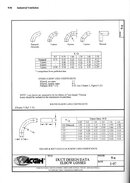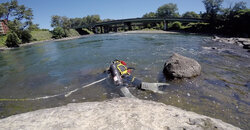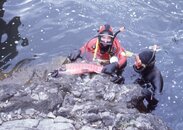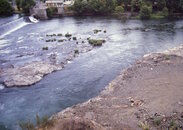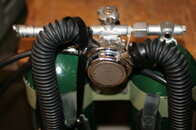Okay, I like a good discussion. So let me tell you where I'm coming from. I am a retired Industrial Hygienist, who has had quite a lot of training in industrial ventilation. I also am a diver who has been diving since 1959, have gone through the U.S. Navy School for Underwater Swimmers, and collects old regulators for use in local rivers. I was a Certified Industrial Hygienist until this year, when I did a "voluntary surrender" of that designation, and had that since 2006. If you'll look at the American Conference of Industrial Hygiene's book, Industrial Ventilation, on page 9-50 there is a figure 9-e which details duct losses. The 90-degree swivel mentioned in this thread is the equivalent of a "Mitered Elbow," and itself has a loss coefficient of 1.2. This is for air at atmospheric pressures, not for compressed air. I would assume that for compressed air, the loss would be greater, due to the greater density of the air. Any turn will cause turbulence in the air flow. When we do an industrial ventilation study, we use some rather complex equations to determine what the velocity pressure losses will be. These could be used in scuba regulators too, as fluid dynamics is much the same, only the losses are increased with the denser air.
Scubapro in the 1970s learned this lesson when the U.S. Navy evaluated their regulators, and the Scubapro Mk 2 out-performed the Scubapro Mk 5. Why? Because the Mark 2 hand a simple cap, with only one LP port, right in the top of the first stage cap, whereas the Mk 5 had a 90 degree turn for convenience for the two LP ports. In NEDU_1980, both the four-port and five port Scubapro Mk V regulators were evaluated. Now, if you'll look at all the Scubapro first stages (piston), you will find that there is one port which is directly in line with the outflow of the piston, in the top of the cap. For best performance, this port should be used for your primary second stage. A long hose, without any turns, is the best for performance as there is greater volume of air (requiring less pressure drop during inhalation), and no turbulence from turns in the air flow.
For the sport diver, under most conditions, this is not a concern. But if you are working hard, at depth, it could be a consideration. For instance, if you are cold (Pacific Northwest diving typically is in cold water), at a depth of say 50 feet, trying to lift a net to the surface, or a bag full of clams, then you will like all the air you can get. If you dive in rivers, with high current, you will want the best-performing regulator you can get.
I have dived Oregon rivers for many moons now, and have used many different regulators, including a large number of the double hose regulators and single hose regulators ever produced in the USA. (I have a fairly large collection.) I have seen a lot of design errors in these regulators, and know intimately the uses and limitations of these regulators. If you'll look at the one photo of me entering High Rocks below, you'll see (visually, it is easy to see in a river) the turbulence that occurs when a fluid turns 90 degrees.
One of my best-performing regulator, which I still dive, as a Scubapro Mk 5 (top of cap LP outlet)/A.I.R. I combination, which I used in the Winchester Dam Project in the 1980s. I have also investigated a few scuba fatalities, one of which involved a regulator which had not been well serviced and was breathing over 5 inches of water pressure, and the fellow was out-of-shape, trying to pull a bag of clams out of an Oregon estuary against a heavy current. So these small things, as Akimbo stated above, can come home to "bite" you.
SeaRat
John C. Ratliff, CSP, CIH(2006-2017), MSPH
Scubapro in the 1970s learned this lesson when the U.S. Navy evaluated their regulators, and the Scubapro Mk 2 out-performed the Scubapro Mk 5. Why? Because the Mark 2 hand a simple cap, with only one LP port, right in the top of the first stage cap, whereas the Mk 5 had a 90 degree turn for convenience for the two LP ports. In NEDU_1980, both the four-port and five port Scubapro Mk V regulators were evaluated. Now, if you'll look at all the Scubapro first stages (piston), you will find that there is one port which is directly in line with the outflow of the piston, in the top of the cap. For best performance, this port should be used for your primary second stage. A long hose, without any turns, is the best for performance as there is greater volume of air (requiring less pressure drop during inhalation), and no turbulence from turns in the air flow.
For the sport diver, under most conditions, this is not a concern. But if you are working hard, at depth, it could be a consideration. For instance, if you are cold (Pacific Northwest diving typically is in cold water), at a depth of say 50 feet, trying to lift a net to the surface, or a bag full of clams, then you will like all the air you can get. If you dive in rivers, with high current, you will want the best-performing regulator you can get.
I have dived Oregon rivers for many moons now, and have used many different regulators, including a large number of the double hose regulators and single hose regulators ever produced in the USA. (I have a fairly large collection.) I have seen a lot of design errors in these regulators, and know intimately the uses and limitations of these regulators. If you'll look at the one photo of me entering High Rocks below, you'll see (visually, it is easy to see in a river) the turbulence that occurs when a fluid turns 90 degrees.
One of my best-performing regulator, which I still dive, as a Scubapro Mk 5 (top of cap LP outlet)/A.I.R. I combination, which I used in the Winchester Dam Project in the 1980s. I have also investigated a few scuba fatalities, one of which involved a regulator which had not been well serviced and was breathing over 5 inches of water pressure, and the fellow was out-of-shape, trying to pull a bag of clams out of an Oregon estuary against a heavy current. So these small things, as Akimbo stated above, can come home to "bite" you.
SeaRat
John C. Ratliff, CSP, CIH(2006-2017), MSPH
Attachments
Last edited:



